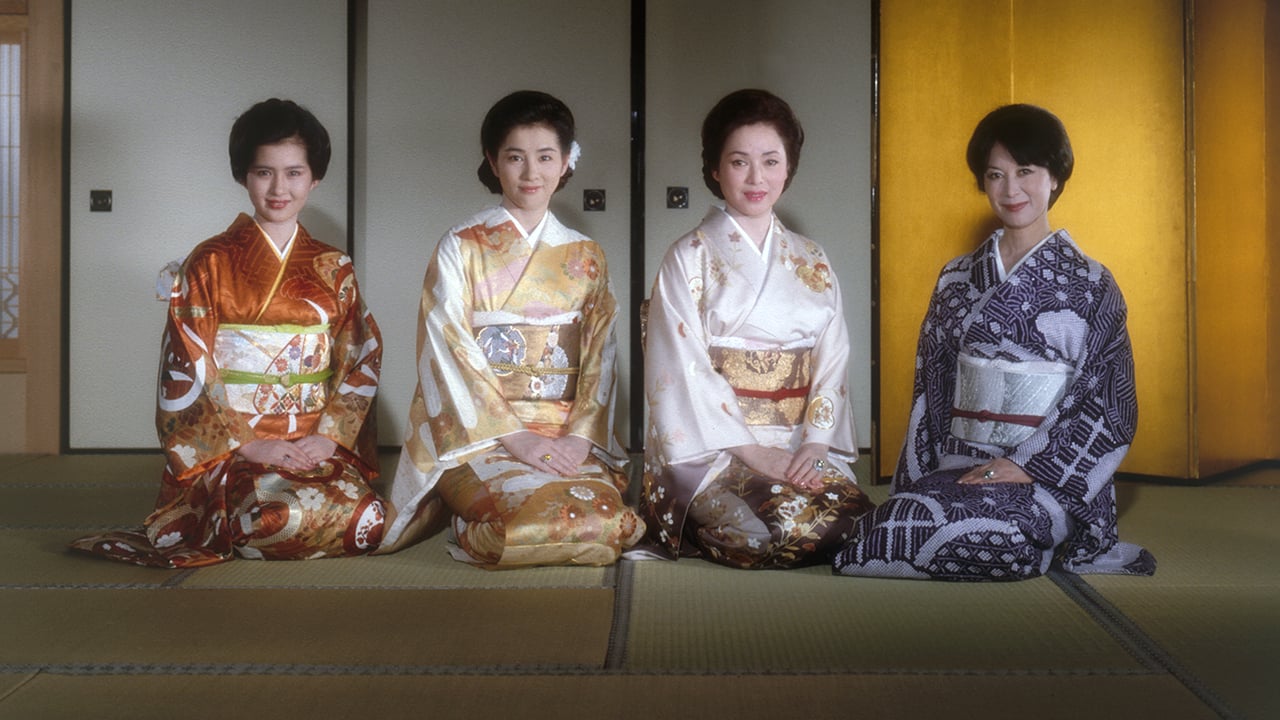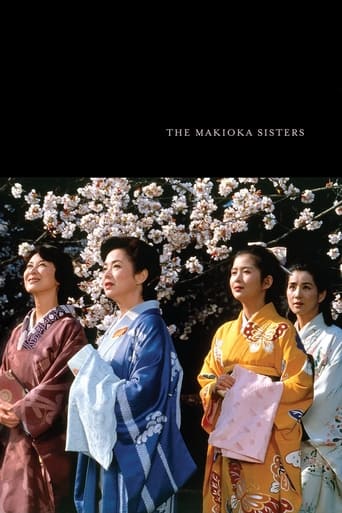

The Makioka Sisters is based on the classic Japanese novel by Junichiro Tanizaki. What I've read about the novel is that it's a rather slow-moving but painstakingly detailed chronicle of a formerly successful Osaka merchant family, now in decline. The novel begins in 1938, shortly before it was actually written. During World War II, a serialization of the novel was canceled by the Japanese government as it was regarded as too 'soft' and 'effeminate', with Tanizaki also accused of not being appreciative enough of the war effort. When the movie was released in 1983, Japan was at the height of economic prosperity and according to the film's notable director, Kon Ichikawa, the Japanese public was not interested in watching anything that could be construed as depressing. The film was made for the 50th anniversary of the Toho film company and who knows to what extent the production company's executives constrained Ichikawa, in being faithful to the novel's original storyline. Simply comparing the plots of the novel and the film adaptation reveals that the film is clearly a sanitized version of the original narrative and despite the ubiquitous histrionics, the 'Sisters' ends with a series of expected happy endings!The family setup is actually quite interesting. The two older sisters, Tsuroko and Sachiko, are both married with Tsuroko's husband, Tatsuo, a bank employee and Sachiko's husband, Teinosuke, an accountant. There are two younger sisters, Yukiko (around 30) and Taeko (maybe around five years younger than Yukiko) who live with Sachiko, her husband and Etsuko, their young daughter. There's quite a bit of resentment amongst the younger sisters toward Tatsuo who they blame (unfairly) for selling off the family business (the film mentions the family were shipbuilders but according to Wikipedia, the novel has them in the kimono business). There are additional reasons why Yukiko and Taeko resent the eldest sister, Tsuroko, and her husband. Since Yukiko is older than Taeko, she's next in line for the family to find her a suitor. Before softening up toward the film's end, Tsuroko wants Yukiko to select a potential candidate as soon as possible, even if he's much too old for Yukiko's taste. There's also a family scandal which occurred five years earlier—it seems rebellious Taeko attempted to elope with local bad boy, Okubata, and it made the papers. It wasn't clear to me from the subtitles in the movie, but according to the Wikipedia article about the novel, the problem arose when Tatsuo demanded a retraction from the paper and they mistakenly substituted Yukiko's name for Taeko's.The main plot of 'The Makioka Sisters' revolves around the various 'marriage interviews' the family arranges for Yukiko. The only potential suitor that proves quite fascinating is a bureaucrat, Nomura, in charge of breeding a particular fish in the government fishery. Nomura's attempt to impress Yukiko is completely laughable. Not only does he display all his diplomas and certificates on the dining table but then pulls out the death certificates for his recently deceased wife and son. To make matters worse, he then compares Yukiko to an 'ayu', the fish species he's so devoted to on his job. If only the rest of characters could be so deliciously drawn as Nomura. Unfortunately, we're left with bores like Yukiko who finally achieves her life dream by snagging the right man: a handsome but blasé son of a viscount from an aristocratic family.More potentially interesting is Taeko, who is the most westernized of the four sisters. She starts her own doll business and still has a thing for Okubata until he introduces her to his former employee, Itakura, a simply and kindly photographer who Okubata becomes jealous of. Okubata ends up becoming the standard villain when he smashes Itakura's camera. Fortunately, Okubata cannot be blamed for Itakura's untimely demise, which began as an ear infection and morphs into a terminal illness. Although Taeko ends up with an 'ordinary' bartender after running away from home, all's well that ends well when she declines to accept her wedding dowry which her father willed to her and declares she'll get by as a seamstress. Many of the arcane descriptions may have worked in the novel but in the film, these character 'quirks' just seem to come out of the blue and don't seem to be organically connected to the plot. When Tsuroko complains about the 'squeaky' sashes she's trying on before one of the 'marriage interviews', she and Sachiko end up giggling hysterically and then rolling on the floor. Perhaps something is lost in the translation and I'm not getting the point of a good many of these scenes. One thing is quite clear, however—the story lacks significant stakes. Somehow, the existential crisis Tsuroko undergoes when she struggles over the news that her husband has been transferred to Tokyo and she'll be forced to move from her idyllic part of the world—that's something that doesn't feel very exciting at all. And again the happy ending: a grateful Tatsuo falls to his knees in front of his wife, thanking her for changing her mind about the big move!Unlike the novel, there's more standard villainy in the film when Okubata extorts money from Teinosuke. It seems that he was responsible for stealing the jewelry he gave Taeko as a gift and now wants the cash equivalent back, because he's flat broke. In the novel something quite different: Taeko ends up pregnant and in order to protect the family's reputation, Teinosuke asks Okubata to keep quiet.Critics who didn't like the film claim that the story's subtlety can be found in the novel and not the film. Perhaps this is just the case where the novel doesn't lend itself to the visual medium. Even relying on subtitles, it's hard to escape the idea that this 'epic' is really a glorified soap opera! The question still arises: how did it end up in the Criterion Collection?
... View MoreKon Ichikawa's "The Makioka Sisters" (aka "A Fine Snowfall") centres on the lives of four upper middle class Japanese sisters during the lead up to the Pacific War. The sisters belong to the Makioka family, a once powerful house which is now witnessing its declining years.The film opens with various misty landscape shots, before settling upon close ups of flower blossoms and petals. Throughout the film, like Ozu, Ichikawa uses ripening fruit and flower buds to suggest impermanence, transience and the passage of time. As Japan awaits change (and bloodshed), the sisters mourn the loss of their parents, fret over their family's finances and battle over tradition. One sister must be wedded to a man before she reaches a certain age, but her moxy and fiery independence (shades of Jane Austen) are at odds with both her biological clock and Japan's customs. Another sister wants to use the family's money to start a doll-making business, but the venture soon gives way to conventional, Western style sewing. All the while, time spirals away, inexorably towards...Much of the film focuses on rituals and customs, most of which are drawn out to the point of parody, or shown to be archaic, laborious and ridiculously inflexible. Holding on to these customs, the eldest sisters believe, will preserve their house's greatness. But these customs, the film shows, are already dead, entombed buds desperately awaiting the new blooms promised by the two youngest, somewhat dissident sisters.The film is stately, melodramatic, lush and colourful, but at times conjures up the spooky lavishness of Kobayashi's "Kwaidan". Ichikawa films the sisters in such a way that they are at times made grotesque and ghostly by ritual. Like John Huston, Ichikawa's filmography is comprised largely of adaptations of highly-regarded literary works. "The Makioka Sisters" was based on a novel by by Junichirô Tanizaki, a major Japanese novelist.8/10 - Worth one viewing.
... View MoreThis is a gorgeous film to watch--you probably will never see a more beautiful view of Japan as you see of the wonderful cherry blossoms or Japanese Maples around Kyoto and Osaka. So, the cinematography is excellent. However, the story itself seemed awfully flat overall. The writing and acting was decent, but the film needed more energy, heart and a sense of humor for me to care more about the characters. Most of the characters would have surely benefited from a massive dose of this, as the way they were portrayed it was, at times, hard to for me to care about them or sustain my interest in the film. For example, the 3rd daughter (who was the one who repeatedly refused marriage proposals) was a bit of a cipher, as she didn't say very much and just used a lot of facial expressions instead of dialog. The youngest, though a little self-destructive, was probably the easiest to like or at least understand. And the two older sisters were very domineering but needed to be softened a little more--lest they seem too one-dimensional. A decent film, but that's all.
... View MoreOne should first read The Makioka Sisters by Junichiro Tanizaki to better understand this film. It is a very great novel about the life of four middle-class sisters in Osaka, Japan in the 1930's. The book describes in great detail the many subtleties of life in Japan which a Westerner can miss understanding in the film. The film rather closely follows the book and is very beautifully photographed.
... View More